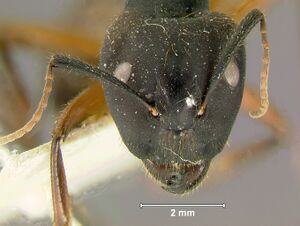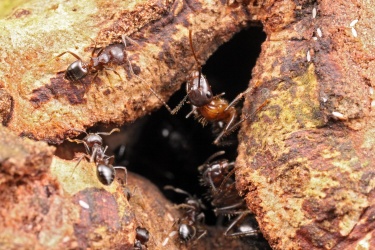Camponotus rufifemur
| Camponotus rufifemur | |
|---|---|

| |
| Scientific classification | |
| Kingdom: | Animalia |
| Phylum: | Arthropoda |
| Class: | Insecta |
| Order: | Hymenoptera |
| Family: | Formicidae |
| Subfamily: | Formicinae |
| Tribe: | Camponotini |
| Genus: | Camponotus |
| Species: | C. rufifemur |
| Binomial name | |
| Camponotus rufifemur Emery, 1900 | |
| Subspecies | |
| |
This species shares a common nest with Crematogaster modiglianii in southeast Asian rainforests.
Identification
Keys including this Species
Distribution
Latitudinal Distribution Pattern
Latitudinal Range: 4.965277778° to -2.183333°.
| North Temperate |
North Subtropical |
Tropical | South Subtropical |
South Temperate |
- Source: AntMaps
Distribution based on Regional Taxon Lists
Indo-Australian Region: Borneo, Indonesia (type locality), Malaysia.
Oriental Region: India, Thailand.
Distribution based on AntMaps
Distribution based on AntWeb specimens
Check data from AntWeb
Countries Occupied
| Number of countries occupied by this species based on AntWiki Regional Taxon Lists. In general, fewer countries occupied indicates a narrower range, while more countries indicates a more widespread species. |

|
Estimated Abundance
| Relative abundance based on number of AntMaps records per species (this species within the purple bar). Fewer records (to the left) indicates a less abundant/encountered species while more records (to the right) indicates more abundant/encountered species. |

|
Biology
While this species is known to nest in ant gardens it does not seem to be a true ant-garden taxon (i.e., one that is able to initiate ant gardens or is restricted to ant gardens) and is more likely to be a secondary resident or opportunistic ant-garden nester (but see Campbell et al., 2022; Menzel & Blüthgen, 2010).
Association with Other Organisms
 Explore: Show all Associate data or Search these data. See also a list of all data tables or learn how data is managed.
Explore: Show all Associate data or Search these data. See also a list of all data tables or learn how data is managed.
- This species is a host for the fungus Ophiocordyceps formicarum (a parasitoid) (Quevillon, 2018) (encounter mode primary; direct transmission; transmission outside nest).
- This species is a host for the fungus Ophiocordyceps unilateralis (a parasitoid) (Quevillon, 2018) (encounter mode primary; direct transmission; transmission outside nest).
Castes
   
| |
| . | Owned by Museum of Comparative Zoology. |
Images from AntWeb
   
| |
| Syntype of Camponotus rufifemur. Worker. Specimen code casent0905438. Photographer Will Ericson, uploaded by California Academy of Sciences. | Owned by MSNG, Genoa, Italy. |
   
| |
| Worker. Specimen code casent0906960. Photographer Michele Esposito, uploaded by California Academy of Sciences. | Owned by NHMUK, London, UK. |
   
| |
| Worker. Specimen code casent0906961. Photographer Michele Esposito, uploaded by California Academy of Sciences. | Owned by NHMUK, London, UK. |
Nomenclature
The following information is derived from Barry Bolton's Online Catalogue of the Ants of the World.
- rufifemur. Camponotus rufifemur Emery, 1900d: 705 (s.q.) INDONESIA (Sumatra).
- Type-material: syntype major workers, syntype queen(s) (numbers not stated).
- Type-locality: Indonesia: Sumatra, Mentawei Is, Sipora I., Si Oban (E. Modigliani).
- Type-depository: MSNG.
- Combination in C. (Myrmotarsus): Forel, 1912i: 92.
- Status as species: Forel, 1907e: 19; Wheeler, W.M. 1919e: 109; Emery, 1925b: 135; Santschi, 1932b: 19; Chapman & Capco, 1951: 240; Bolton, 1995b: 121; Jaitrong & Nabhitabhata, 2005: 15; Pfeiffer, et al. 2011: 38; Bharti, Guénard, et al. 2016: 25; Khachonpisitsak, et al. 2020: 45.
- Distribution: India, Indonesia (Sumatra), Malaysia (Sarawak), Thailand, Vietnam.
- Current subspecies: nominal plus obscurus.
Description
References
- Adams, R.M.M., Wells, R.L., Yanoviak, S.P., Frost, C.J., Fox, E.G.P. 2020. Interspecific Eavesdropping on Ant Chemical Communication. Frontiers in Ecology and Evolution 8. (doi:10.3389/fevo.2020.00024).
- Beutel, R.G., Richter, A., Keller, R.A., Hita Garcia, F., Matsumura, Y., Economo, E.P., Gorb, S.N. 2020. Distal leg structures of the Aculeata (Hymenoptera): A comparative evolutionary study of (Sphecidae) and (Formicidae). Journal of Morphology 281, 737–753 (doi:10.1002/JMOR.21133).
- Campbell, L.C.E., Kiers, E.T., Chomicki, G. 2022. The evolution of plant cultivation by ants. Trends in Plant Science (doi:10.1016/j.tplants.2022.09.005).
- Emery, C. 1900d. Formiche raccolte da Elio Modigliani in Sumatra, Engano e Mentawei. [part]. Ann. Mus. Civ. Stor. Nat. 40[=(2(20): 689-720 (page 705, soldier, queen described)
- Forel, A. 1912j. Formicides néotropiques. Part VI. 5me sous-famille Camponotinae Forel. Mém. Soc. Entomol. Belg. 20: 59-92 (page 92, Combination in C. (Myrmotarsus))
- Hackmann, A., Delacave, H., Robinson, A., Labonte, D., Federle, W. 2015. Functional morphology and efficiency of the antenna cleaner in ants. Royal Society Open Science 2, 150129 (doi:10.1098/RSOS.150129).
- Khachonpisitsak, S., Yamane, S., Sriwichai, P., Jaitrong, W. 2020. An updated checklist of the ants of Thailand (Hymenoptera, Formicidae). ZooKeys 998, 1–182 (doi:10.3897/zookeys.998.54902).
- Menzel, F., Blüthgen, N. 2010. Parabiotic associations between tropical ants: Equal partnership or parasitic exploitation? J. Anim. Ecol. 79: 71–81.
- Yamane, S., Tanaka, H.O., Hasimoto, Y., Ohashi, M., Meleng, P., Itioka, T. 2021. A list of ants from Lambir Hills National Park and its vicinity, with their biological information: Part II. Subfamilies Leptanillinae, Proceratiinae, Amblyoponinae, Ponerinae, Dorylinae, Dolichoderinae, Ectatomminae and Formicinae. Contributions from the Biological Laboratory, Kyoto University 31, 87–157.
References based on Global Ant Biodiversity Informatics
- Bluthgen N., D. Mezger, and K.E. Linsenmair. 2006. Ant-hemipteran trophobioses in a Bornean rainforest- diversity, specificity and monopolisation. Insectes Sociaux 53: 194-203.
- CSIRO Collection
- Chapman, J. W., and Capco, S. R. 1951. Check list of the ants (Hymenoptera: Formicidae) of Asia. Monogr. Inst. Sci. Technol. Manila 1: 1-327
- Emery, C.. "Formiche raccolte da Elio Modigliani in Sumatra, Engano e Mentawei." Annali del Museo Civico di Storia Naturale Giacomo Doria (Genova) (2) 20, no. 40 (1900): 661-722.
- Forel A. 1907. Formiciden aus dem Naturhistorischen Museum in Hamburg. II. Teil. Neueingänge seit 1900. Mitt. Naturhist. Mus. Hambg. 24: 1-20.
- Hashimoto Y., Y. Morimoto, E. S. Widodo, and M. Mohamed. 2006. Vertical distribution pattern of ants in a Bornean tropical rainforest (Hymenoptera: Formicidae). Sociobiology 47(3): 697- 710.
- Jaitrong W., and T. Ting-Nga. 2005. Ant fauna of Peninsular Botanical Garden (Khao Chong), Trang Province, Southern Thailand (Hymenoptera: Formicidae). The Thailand Natural History Museum Journal 1(2): 137-147.
- Pfeiffer M.; Mezger, D.; Hosoishi, S.; Bakhtiar, E. Y.; Kohout, R. J. 2011. The Formicidae of Borneo (Insecta: Hymenoptera): a preliminary species list. Asian Myrmecology 4:9-58
- Santschi F. 1932. Résultats scientifiques du voyage aux Indes orientales néerlandaises de LL. AA. RR. le Prince et la Princesse Léopold de Belgique. Hymenoptera. Formicidae. Mémoires du Musée Royal d'Histoire Naturelle de Belgique. (2)4: 11-29.
- Wheeler W. M. 1919. The ants of Borneo. Bulletin of the Museum of Comparative Zoology 63:43-147.
- Widodo E.S., M. Mohamed, and Y. Hashimoto. 2001. Canopy ant diversity assessment in the fragmented rainforest of Sabah, East Malaysia. Nature and Human activities 6: 13-23.
- Wriedt J., D. Mezger, L. Chong, and M. Pfeiffer. 2008. Observations on the foraging behaviour of Myrmicaria brunnea subcarinata (Smith) (Hymenoptera: Formicidae) in a tropical rainforest in Sarawak (Malaysia). Asian Myrmecology 2: 109-120.
- Zryanin V. A. 2011. An eco-faunistic review of ants (Hymenoptera: Formicidae). In: Structure and functions of soil communities of a monsoon tropical forest (Cat Tien National Park, southern Vietnam) / A.V. Tiunov (Editor). – M.: KMK Scientific Press. 2011. 277 р.101-124.


